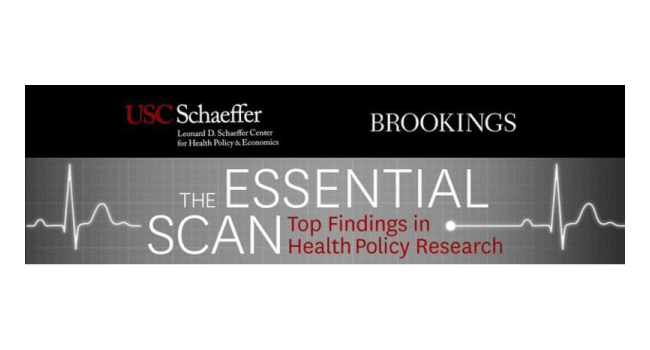What’s the latest in health policy research? The Essential Scan aims to help keep you informed on the latest research and what it means for policymakers. It is produced by the USC-Brookings Schaeffer Initiative for Health Policy, a collaboration between the Brookings Institution and the USC Schaeffer Center for Health Policy & Economics. To sign up to receive the Essential Scan straight to your inbox, sign up here.
Did the ACA Medicaid Expansion Save Lives?
Study by: Mark Borgschulte and Jacob Vogler
Medicaid is the largest social insurance program in the U.S. and while there is substantial evidence the program helps reduce financial risk for its beneficiaries, there is less evidence linking access to long-term health benefits and mortality. A new study examines the impact of the Affordable Care Act Medicaid expansion on adult mortality by analyzing data from the first four years following the expansion. The researchers leverage the post-expansion changes in mortality between counties in states that expanded Medicaid in 2014 with those that did not. The researchers estimate the expansion resulted in a 3.6% decrease in all-cause mortality in adults ages 20 to 64, with the reduction largely driven by counties with the lowest rates of insurance coverage before Medicaid expansion and by causes of death likely to be influenced by access to healthcare. Full study here.
“These results are important because the study takes advantage of the ‘natural experiment’ of some states not expanding the program over the period.”
Paul Ginsburg, PhD
Director, USC-Brookings Schaeffer Initiative for Health Policy
Sources of Geographic Variation in Healthcare Spending Among Individuals with Employer Sponsored Insurance
Study by: William C. Johnson and Jean Fuglesten Biniek
Healthcare spending for commercially-insured individuals varies widely across geographic areas in the U.S, due in part to differences in price and utilization of services. A new study examines the extent to which geographic variation in commercial healthcare spending is attributable to person-specific demand factors or place-specific supply factors. The authors use claims data from 2012 to 2016 from the Health Care Cost Institute, which accounts for approximately one quarter of the commercially insured population in the United States, across 112 metropolitan areas. The researchers find that an individual moving to a metro area with 10% higher spending relative to their origin is predicted to have a 4.2% increase in their medical spending, implying that 42% of variation in medical spending across metro areas is due to place-specific factors and the remaining 58% is attributable to person-specific factors. With all else held equal, the authors find that moving to an area with 10% higher prices, on average leads to a 5% increase in spending, while moving to an area with 10% higher utilization leads to a 3.6% increase in spending. Overall, the study’s analysis of the spending patterns of the commercially insured reflects and extends previous findings in the Medicare, near-elderly commercial, and military populations in the United States. Full study here.
Study by: Geoffrey T. Sanzenbacher and Gal Wettstein
As markets change to accommodate new policies associated with the ACA and Medicare Part D, coverage expansions may increase drug utilization through consolidating demand and directing a large number of consumers to a relatively small number of insurers. A new study leverages two factors – drugs used predominately by those ages 65 and older and the implementation of Part D – to identify the effects of insurance coverage expansion on the behavior of manufacturers. The researchers found Part D increased the frequency of evergreening (efforts to maintain market power by managing the product life cycle) on the part of branded manufacturers by 6.2 percentage points and decreased the incidence of generic entry by 20 percentage points for drugs used exclusively by adults in the Part D population (those ages 65 and older). However, the researchers also found that prices fell for drugs used frequently by seniors relative to other products, which was likely due to insurer buying power. Products that had exclusivity due to evergreening practices were more expensive than those that didn’t. Full study here.
Insurance Design and Pharmaceutical Innovation
Study by: Leila Agha, Soomi Kim and Danielle Li
Pharmaceutical insurance coverage policies, often dictated through PBMs, might affect incentives for future innovation. A new study analyzes the effects of closed formularies, a practice of excluding coverage for certain new drugs when substitutes are available, which gained popularity starting 2012, on innovation investments. The researchers found between 2012 and 2017, 300 drugs were excluded by at least one of the three largest PBMs in the U.S. According to the study, exclusions were more common in drug classes with more pre-existing therapeutic options and in classes with a large number of patients. Linking this finding to innovation, the researchers find that R&D declined the most in drug markets with a high number of existing therapies that were for common diseases, such as diabetes and cardiovascular diseases. Taken together, these findings suggest pharmaceutical firms anticipate downstream payment policies and shift their R&D efforts according. As such, policymakers may want to consider including insurance design in their proposals aimed at encouraging and directing investments in innovation. Full study here.
Click here to receive The Essential Scan email.
The Essential Scan is produced by the USC-Brookings Schaeffer Initiative for Health Policy, a collaboration between the Brookings Institution and the USC Schaeffer Center for Health Policy & Economics.
